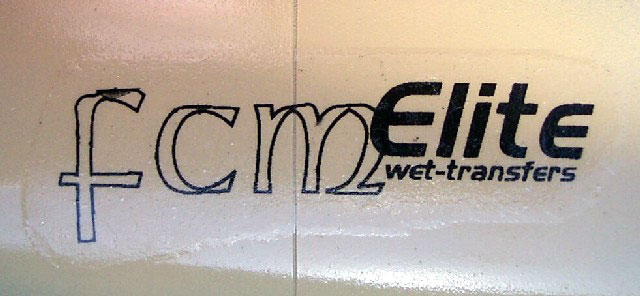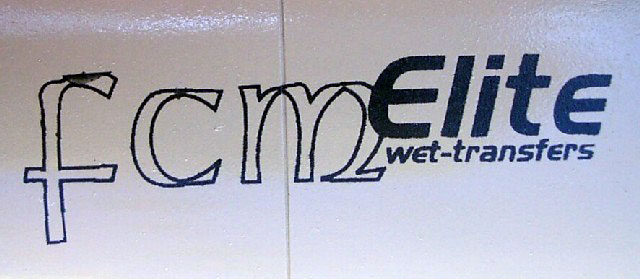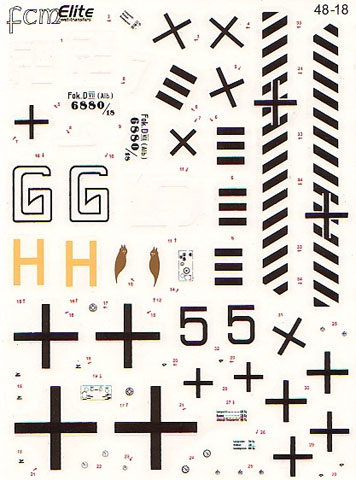|
S u m m a r y
|
| Catalogue
Number: |
Elite wet transfers #4818
Fokker D.VII |
| Scale: |
1/48 scale |
| Contents and Media: |
One wet transfer sheet and
instructions |
| Price: |
Around USD$10.00 from model
retailers worldwide |
| Review Type: |
Preview |
| Advantages: |
No resultant carrier film,
accurate markings, interesting schemes, decals to practice with. |
| Disadvantages: |
Buying enough D.VII kits to
satisfy the craving! |
| Recommendation: |
Highly Recommended |
Reviewed by Rob Baumgartner

vailable online from Squadron.com
 With
the arrival of the new Fokker D.VII kits in this scale, FCM’s latest
release is bound to be popular for lovers of this famous aircraft. With
the arrival of the new Fokker D.VII kits in this scale, FCM’s latest
release is bound to be popular for lovers of this famous aircraft.
Having not tried their product before, I was keen see
how the “wet transfers” would perform.
Upon inspection, one is presented with a sheet that
doesn’t just contain the aircraft’s markings. Here we find a nice
selection of instrument faces including the compass, fuel gauge, two types
of instrument panel, three different weight tables, and Axial prop logos.
Printing was good on my example with the colours not
being the overly bright renditions seen elsewhere.
The first thing you notice when looking at the sheet
is what appears to be a very thick carrier film. The builder need not
worry here, as this is not the traditional water slide decal that most
modelers are used to.
The “decal” is floated onto the model in the usual
fashion and then pressed down to remove any air bubbles. After waiting a
suitable time for the transfer to dry, the protective carrier film is
carefully lifted at one edge and pulled away. The result is an image that
looks painted on. No surrounding carrier film, just the image.
Decal setting solutions can be used but I found them
unnecessary. Besides, it only makes the carrier film harder to remove! To
ease this, I suggest sliding a slip of paper under one edge of the clear
film straight after the transfer has been applied. If the instructions are
followed correctly, there is no risk of the image being pulled off the
model.
Thoughtfully FCM give you a small sheet of markings
where you can practice using the product.
Before:

During:

After:

FCM recommend the Roden, Revell or Dragon kits for
the Fokker D.VII. As these kits have differing dimensions, it will pay to
test fit the required marking on your subject before you commit yourself
to application.
When compared to the Roden offering, the fuselage
markings fitted as if they were designed for this kit. The “G”, and “5”
personal markings also fitted the wings very well.
Although the underside versions fitted their location
perfectly, the upper wing crosses are a little short for the Roden kit.
This is not really a problem as the kit items can usually replace the
latter.
All manufacturers of the D.VII are represented on the
sheet so a scheme is available for any of the forthcoming kit releases.
-
 Fokker
D.VII (Albatros built), Ltn.d.R. Hermann Gilly, Jasta 40 Fokker
D.VII (Albatros built), Ltn.d.R. Hermann Gilly, Jasta 40
Hermann Gilly joined Jasta 40 in April of 1918 and
it was here that he scored all of his 7 victories. He survived WWI to
become a Major in the Luftwaffe of the second great conflict.
His machine was an Albatros built example and is
thought to have been covered in 4-colour lozenge.
- Fokker D.VII (Albatros built), Ltn.
Carl-August von Schoenebeck, Jasta 33
He gained his first three victories with Jasta 11 and scored a fourth
after transferring to Jasta 59. When he finally did arrive at Jasta 33
he gained four more victories, which brought his final tally to 8.
Interestingly his first aerial conquest was the famous triplane “Black
Maria”. This had previously been Raymond Collishaw’s 18 victory aircraft
although on this occasion it flown by FSL G. Roach
- Fokker D.VII (Fokker built), Uffz.
Fritz Haack, Jasta 46
Builders should note that this was a BMW powered
aircraft and if using the Roden kit, engine parts V3 and V4 apply. It’s
nice to see that FCM didn’t forget the necessary “G” marking that was
found underneath each wing.
- Fokker D.VII (Albatros built), Vzfw.
Oskar Hennrich, Jasta 46
After joining Jasta 46 in May 1918, Hennrich soon
became its highest scoring pilot with 20 victories, 13 of which were
balloons. Note that this machine was also BMW powered. Interesting the
lower wings are said to be OAW built even though the rest of the
airframe is attributed to Albatros.
- Fokker D.VII (Fokker built), Jasta
26
Sadly this striking Jasta 26 machine must remain
pilot less. What is assumed to be the pilot’s personal marking is
present on the fuselage and in this case is the number 5. JG III
practice was to repeat this on the top wing and again FCM correctly
supply this.
- Fokker D.VII (OAW built), MFJ III
The Marine-Feldjagdstaffeln was the source of some
of the most spectacularly coloured D.VIIs and this one is no exception.
Believed to be 4499/18 and the mount of Vizeflgmstr. Franz Mayer, it was
this aircraft that allowed him to score his 4th victory.
I really enjoyed trying these decals and found the results to be very
satisfying. Don’t be put off by the appearance of what looks to be a layer
of thick carrier film as this is not the traditional water slide decal.
The references used are the Albatros Publication
series on the Fokker D.VII so the accuracy of the schemes is as good as
one is likely to get barring further information coming to light.
Highly Recommended
Thanks to
Felipe from FCM
for the review sample
Click here
to view a list
of FCM distributors
Preview Text Copyright © 2003 by
Rob Baumgartner
This Page Created on 17 December, 2003
Last updated
17 December, 2003
Back to
HyperScale Main Page |
Home | What's
New | Features
| Gallery |
Reviews | Reference
| Forum
| Search